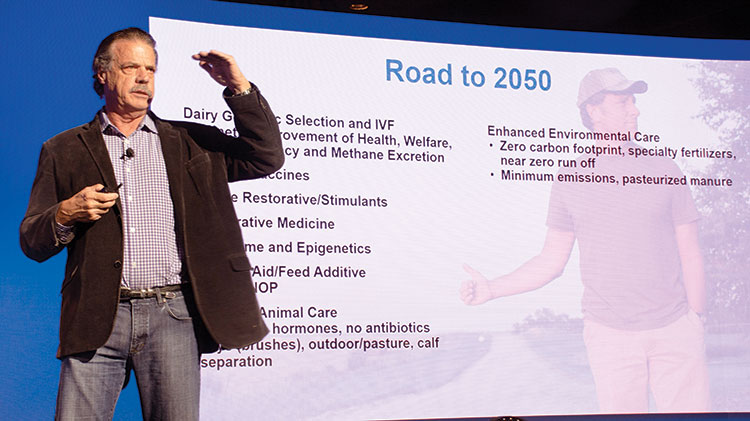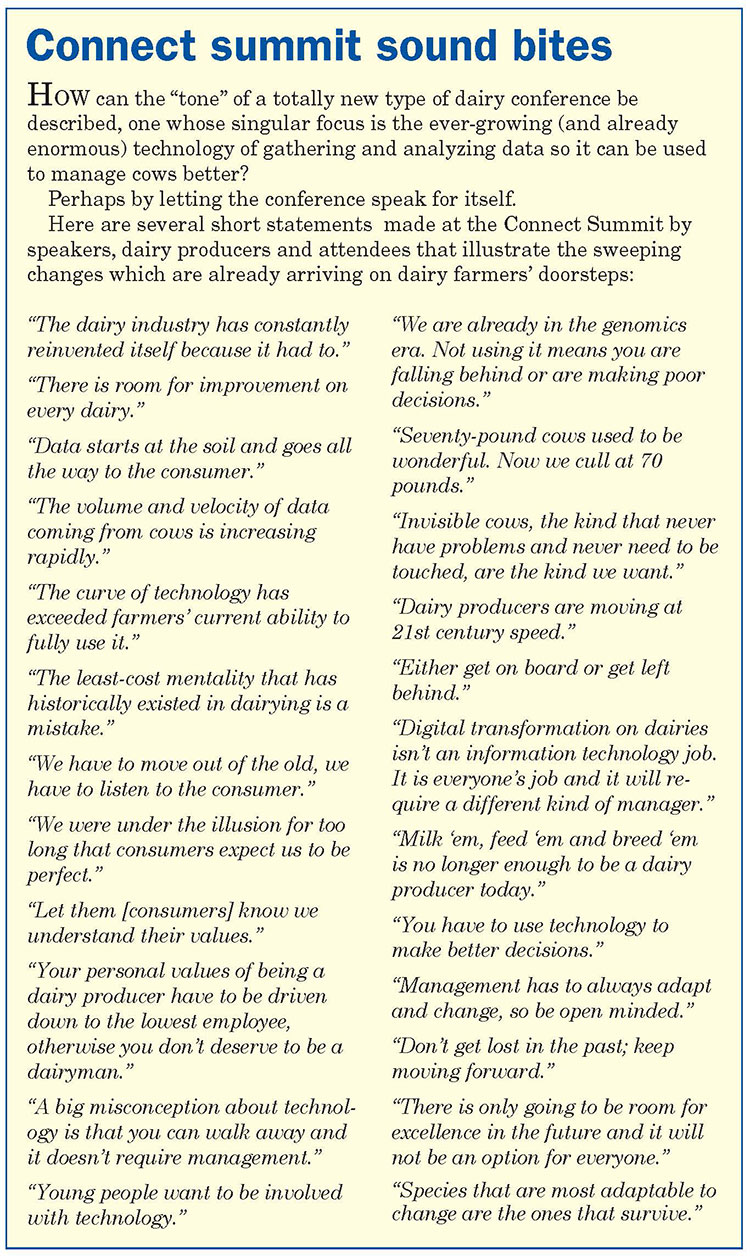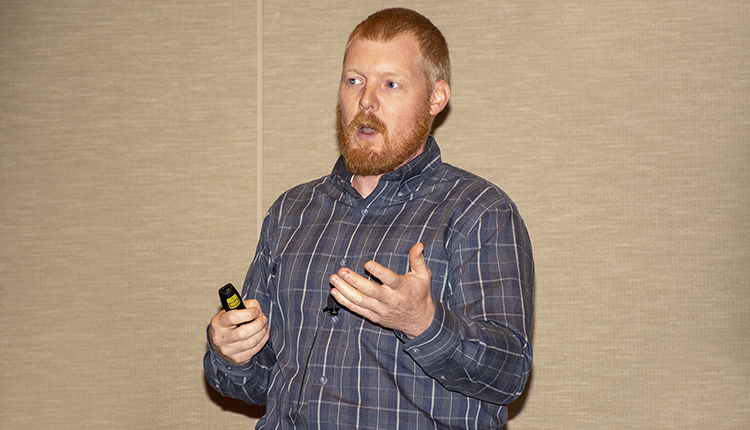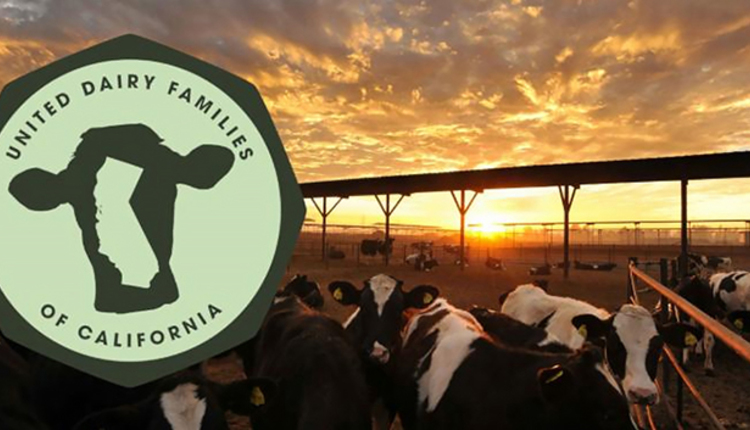
Thirty-two years is a long way in the future, but dairyman Mike McCloskey has some strong ideas about technology tools the industry will use to get there.
He’s a visionary who wears many hats — milk producer, veterinarian, cooperative leader (Select Milk Producers), new product innovator (co-founder with Coca Cola of fairlife ultra-filtered milk), industry advocate, and consumer educator (operator of the 15,000-head Fair Oaks Farms Dairy Adventure in Indiana).
With his track record of success and excellence, his predictions deserve serious consideration.
McCloskey was the “set the tone” speaker at the Connect 2018 dairy technology summit in Beaver Creek, Colo., in late June. It was a first-of-its-kind event that examined new technology tools using “big data” that are either here or in development that may transform the dairy industry faster than ever before.
Robots just the start
It is a future in which robots will be only part of the story. The most dramatic gains figure to come from new and tremendously wider applications of science — genetics, genomics, the microbiome (all biologic components in a cow’s environment), and epigenetics (changes in organisms caused by modification of gene expression, rather than alteration of genetic codes).
In other words, when it comes to new technology dairying probably hasn’t seen anything yet.
“As we look back the last 30 years at the technology on our farms, it has just been amazing what we have accomplished,” said the innovative McCloskey. “Not only from a productivity point of view, but also the quality of product, the health of animals, and the comfort of animals. We produce the highest quality milk in the world; the raw somatic cell counts in our milk and the decrease in mastitis from where we were 30 years ago is phenomenal.
“One thing I think we should be proudest of is how we have attacked the environmental issue,” he added. “We truly are putting an effort into figuring this out as an industry like no one else in agriculture is doing.”

Herd averages of 150 lbs.
“Road to 2050” was the frame around his wide-ranging and inspiring talk about technology, environmental responsibility, new product innovation, co-op activities, animal care, and consumer perception. He grabbed listeners’ attention early by telling them the industry is on its way to a 150-pound daily per-cow production average.
“We’re looking at getting 3 to 4 times more productivity out of our genetics over the next 30 years as we did the previous 30,” he said, adding that genomics will lead the way.
“If you go back to the previous 30 years as compared to now, think about (A.I.) bulls. To get approximately 70 percent repeatability you were looking at eight years (of daughter production data). Today we are looking at 20 months,” he explained.
“The advancement we’re going to see just from the bull side is over threefold. But the other part of this is in vitro fertilization (IVF). We will see entire herds being bred with five percent of your genetics — which obviously will be the highest producing genetics in your herd. But those genetics will also be selected based upon health improvements and feed efficiencies. Just think of 30 more years of working on this and where we’re headed.”
It is a compelling thought that actually makes the 150 pounds by 2050 prediction seem conservative.
McCloskey is also “incredibly excited” about improved vaccines and products that will restore or stimulate immune function, the massive potential of stem cell-based technology, and digestive aids that will reduce cows’ production of the green house gas methane. That one, in fact, is already being developed with help by the dairy industry via Dairy Management Inc. (DMI).
“I’m going pick a disease that keeps me up at night,” he said, “and I think it keeps the entire dairy world up at night: hoof and mouth disease. I predict that within 10 years we will have a vaccine against hoof and mouth disease. If we have that, then the other vaccines in our herds are going to be phenomenal.”
He explained that regenerative (stem cell-based) medicine technology is advancing at an incredible rate and is getting incredibly inexpensive. “I predict that within five years we will see on our dairies a mastitis treatment that, because of early detection, we will be able to use.”
Two scientific terms that milk producers may not be familiar with right now are already hotbeds of current scientific research: microbiome and epigenetics. McCloskey said both will play important roles on dairies in the next 30 years.
“Microbiome is just a fancy term for all of the microorganisms that exist on our farms, and more importantly those that exist in our cows,” he explained. “Understanding and managing this is a major focus of attention today. Over the next 10 years we will learn practical things that will be working on our dairies to protect cows and make them healthier and more productive.
Turn genes on or off
“Epigenetics is the intersection of expression by genes,” he added. “With epigenetics you can turn on or turn off good and bad genes by manipulating certain factors, and we will see a lot of developments in this area over the next 10 to 15 years.”
With such technologies and tools, McCloskey believes that, “It’s going to be very rare we would need or use hormones or antibiotics.”
The methane inhibitor product being developed interferes with the metabolic pathway so a significant amount of methane is converted into butyric acid, which McCloskey pointed out is a positive for cows.
“It will put a little more weight on cows and actually increase a little of the protein. But more importantly, it decreases 40 percent of belching (a big source of methane pollution into the atmosphere). That’s a huge story. And the cost of the product should come in relatively inexpensive based upon increased weight and protein.”
The environment, farm sustainability, animal care practices, (access to pasture and calf separation from dams in particular), and consumer perceptions will continue to be challenges for the dairy industry, but McCloskey is confident the industry can address them all.
“This is already occurring in Europe; it’s a big trend and it’s one we’ll have to deal with sooner or later,” he said. “I put it out there because I think we have enough ingenuity that we probably can figure out a way to both get an economic benefit out of it and meet what the consumer is going to be demanding in the future.”
“Sustainability” may be one of the most used, yet least defined, consumer buzzword of the 21st century, but for McCloskey it comes with a must-have component — profitability.
“When you look at sustainability and how we’ve operated our farms and where we’re headed, I suggest we don’t do anything that is not truly sustainable,” he advised. “To be sustainable we have to be able to get an economic return on it, without a doubt. But it has to be an improvement on what we were doing before.”
Zero carbon footprint
A big “wow” part of his presentation was a prediction that dairy farms may one day be able to achieve a zero carbon environmental footprint.
“I really believe we can get there,” said McCloskey. “With the advancement of farming practices and with new products, I can model today that 10 or 15 years from now we can have a story to the consumer of a zero carbon footprint, or even a negative footprint, on a gallon of milk. Almond, soy, and rice milk can’t do that. But we will be able to do that.”
Widespread adoption of robotic milking technology is already well underway in the U.S., but more so by small herds. He says that is going to change rapidly, however.
“I will say that in 10 years I think it would be very hard for a dairyman to make a decision to build a dairy that wouldn’t (milk) robotically. The way this is going to take off is we’re going to integrate it into existing farms. Obviously, some cows will never go to the robot milking parlor, but they’ll benefit from the other assets in that unit, including the management at that farm.”
McCloskey is a big believer in co-ops and the good they have done for dairy farmers. But as he looks ahead to the next 30 years he is concerned about what is happening in the U.S. — the rest of the world is looking at and taking our marketplace.
Of the 20 largest dairy companies in the world, he said only four are headquartered in the U.S. and just one, Dairy Farmers of America, is owned by U.S. dairy farmers. The three biggest global dairy companies, Nestle, Danone, and Lactalis, all have facilities in the U.S.
“They’re coming in, they’re buying up our processing, creating brands, and taking our marketplace. That’s a concern,” he said.
“We as dairy farmers are at a little bit of a crossroads on this one, and as future leaders of this industry, everyone in this room needs to be thinking about ‘What do I want to be? Do I want to end up like the hog industry, or do I want to own this product and the processing and the branding?’”
“The other thing added to this is, we are trained to a least-cost mentality. But as you move up the (distribution) chain, it is amazing how that least-cost mentality doesn’t work. When you’re in the branded world there is not a least-cost mentality.
“I think it would be a tremendous mistake if dairy farmers of the U.S. were to end up like hog farmers,” he warned. “I think it is extremely important that our leadership over the next hopefully 10 years — I’m not going to say 30 because that will be too late — make sure that we do not lose our markets and that they belong to U.S. dairy farmers.”
Given his great success as an entrepreneur, McCloskey strongly believes that becoming more than just a supplier of raw milk is the path to greater farm profitability.
“If you want to stay in the game you want strategy,” he said. “And strategy will then give you the ability to get into processing and branding. It is a distinct set of skills that we need to put together, but we should have no fear of it because dairy farmers understand intrinsically every aspect of this. I am very comfortable that we as dairy farmers have the total ability to control our market all the way to the consumer.”
But in order for milk producers to do so he believes co-ops will have to fundamentally change. He said they will need to stop performing just a balancing, pass-through function and instead add value to milk that is returned to producers.
Take back our markets
“I hope that in the next 10 years we dairy farmers see this vision and force our organizations to figure out how to control this and take back our markets from companies that are buying our milk at a commodity price, creating value, and taking the money back to where they are based,” McCloskey said.
“More importantly, why aren’t we going to their countries and taking over their markets, which is the direction we should go because we are truly the most efficient dairy farmers in the world without a doubt.”
However, going beyond farm fences and becoming more involved in product branding and marketing will magnify the importance of dairy producers earning consumers’ trust. Truth and transparency in all things and at all times will be paramount.
“We have a very confused consumer today,” McCloskey explained, “because she is hearing from all kinds of people in the 98 percent who are not involved in agriculture — but not from the two percent who are. Through our industry work and co-op leadership we are putting a tremendous effort into having a fact-based consumer. Five years ago I would have said this isn’t looking good, but I have to tell you today that we have turned the corner.
“But we are only as good as our weakest link without a doubt,” he warned. “The problem with our industry and the problem with co-ops is that we play to the middle. We used to play to the lowest common denominator, but over the last 10 to 15 years we’ve started realizing what we are up against so now we are playing to the middle.
“The change that has to come in the next 10 years is we have to play to the highest standards and everyone has to participate. Those who don’t want to participate may need to go and become (crop) farmers. That is a change that is occurring now and it is why I can tell you I feel we have turned the corner. Not only us as an industry, but also our communication to consumers.

It’s all about trust
“This is all about trust, and trust is about shared values. We have an incredible amount of shared values with consumers; we’re just not getting them out there well enough.”
McCloskey did not ignore the incredibly rare, but still powerful, black eyes to the dairy industry that are caused by undercover animal abuse videos by anti-animal protein groups.
“How do they get us? With these videos of people that, unfortunately, are not paying enough attention,” he stressed. “We know it’s a very small percentage of dairy farms and we know that none of us have ever seen a dairy farmer in one of those videos abusing a cow. So we know that isn’t who we are.
“But we have to understand that your personal values as a dairy farmer have to be driven to the very last employee on your farm, and if you’re not capable of doing that you don’t deserve to be a dairyman,” he said. “That’s the approach we’re going to have to take. We can’t play to the middle anymore. This is how we’re going to win this conversation.”
McCloskey isn’t just hopeful that dairying has the message consumers want and the ability to communicate it, he’s confident that it does.
“This consumer doesn’t want to be confused,” he said. “They really care. And no one has our story; not even close. When you look at the next 30 years and you think about the environmental care we’re going to have on our farms and the animal care we’re going to have, dairy farmers are going to be a filter for carbon in the world. They’re going to beg us to farm more. We’re headed that way.
“We have to have a story, a true transparent story. But more importantly, we’ve got to be able to stand behind it and we’ve got to play to the highest standard, not to the middle, if we’re going to win this game.
“It’s up to us as dairy farmers, and we can do this. I have no doubt that we are the best of the best.”










